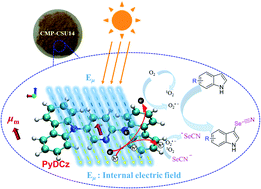Polarization-induced charge separation in conjugated microporous polymers for efficient visible light-driven C-3 selenocyanation of indoles†
Abstract
Conjugated microporous polymers (CMPs) are cost-effective photocatalysts in organic transformations, while they are usually limited by the insufficient separation of photogenerated charges. Here we report a polarization strategy through molecular geometry optimization to promote the charge separation of CMPs. Three CMP photocatalysts with an alternative donor–acceptor skeleton and tunable symmetry were synthesized by the oxidative coupling of bis-carbazoles with electron-deficient bridges (benzene/pyridine/pyrimidine). Simply regulating the polarization of the starting monomers leads to tailorable porosity, photoelectric properties, and photocatalytic activity of the CMPs. They exhibited high efficiency in C-3 selenocyanation of indoles under visible-light and at room temperature, and pyridine-based CMPs with the largest dipole moment gave a yield of up to 94%, superior to their state-of-the-art photocatalyst counterparts. Photo-physical experiments combined with theoretical calculations further supported that the incorporation of the polarized linker introduced an internal electric field, benefitting efficient charge separation. This offered new insight into developing high-performance photocatalysts.



 Please wait while we load your content...
Please wait while we load your content...